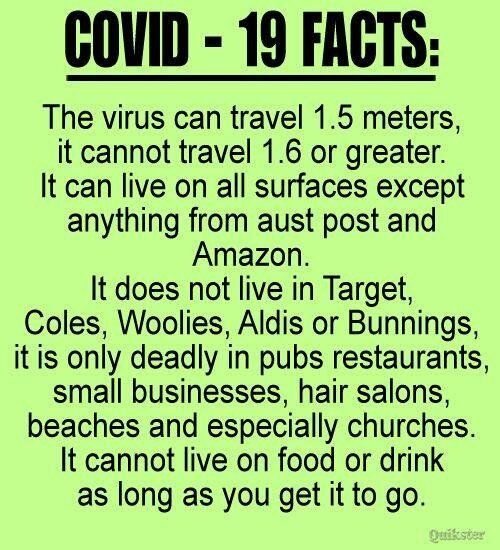My mother reposted this image of supposed 'facts' about COVID-19 on Facebook, which got me angry and worked-up. I don't know if this was meant to be funny or sarcastic, but regardless, it is not funny and there are ignorant people out there who would believe it to be true, and believing that the coronavirus pandemic is a hoax. This is the kind of bullshit misinformation I was referring to in my last post. Every 'fact' mentioned is wrong or misleading.

- There is nothing magical about the 1.5m/6ft distance. You can contract the coronavirus if the infected person is 1.6m or 2m or even 5m away from you. It depends on multiple factors like if there are droplets in the air (the infected carrier recently sneezed or coughed), if you touched a surface that those droplets landed on, the ventilation and air circulation of the area, whether you're directly downstream from an air conditioning vent that is blowing the virus-laden air in your direction, and the duration you spend in that environment and proximity to the carrier. The CDC/WHO recommendation for 1.5m/6ft social distancing came from research in the 1930s on the spread of viruses and bacteria, but some scientists are now saying that's outdated, and it should be higher than that. In the end of the day it's a trade-off because in densely populated places and indoor areas, it's already difficult to maintain a 1.5m distance much less 5m, which is why you would combine social distancing with other measures like wearing a face mask to protect yourself and others to limit the spread.
- the materials that the virus can survive on, and the duration, varies. It appears to linger on solid, non-porous surfaces like plastic and some metals the longest (though some metals like copper have anti-bacterial/viral properties). It appears that it doesn't survive as long on fabrics and cardboard boxes, but that's not to say it can't spread that way - it can still be infectious if someone (say, your postal delivery person) coughed on it or touched something else that has the virus on it, then handed it to you an hour later. And yes, the virus can still be active on your paper or fabric face masks, so don't touch it anywhere other than the straps, or if you do, wash your hands immediately.
- supermarkets and grocery stores are allowed to remain open as they are essential businesses and people still need to get food and household items. You can still contract the coronavirus while shopping at Target or Aldi or Bunnings. A pub is not essential and the primary purpose for being at a pub is to socialise, drink and eat, in a confined indoor space. It's nearly impossible to maintain a 1.5m distance from your mates and other customers in a pub, and everybody would be talking while eating and drinking and spewing droplets from their mouth all over the place, which will linger on surfaces and in the air for hours, long after the infected person has left the premises. A supermarket is lower risk because they tend to be larger open plan areas with better air circulation and there's a bit more room for customers to try to avoid each other, and you tend not to have long conversations with your fellow shoppers or staff who work there. You can even buy alcohol in some shops to take home in a socially distant manner and not expose yourself and others in a pub.
- Same thing with churches and hair salons where you'd be in close contact in a confined indoor space (you can't have a haircut with your hairdresser standing 1.5m away, and you will not be his/her only customer that day), for what could be an extended period of time, with people talking and singing - once again spewing droplets. It's not deliberate discrimination against certain types of businesses or religious beliefs, it's about limiting the spread of the contagion for the sake of public safety by closing down places that are high-risk and non-essential. Same for gyms, nail salons, cinemas, stadiums, nightclubs, museums and galleries. Parks and beaches have been allowed to remain open because they are open outdoor spaces, but only as long as people can remain 1.5m (or more) from each other. It's overcrowding that turns them into potential hotspots for viral spread.
- restaurants doing takeaway orders is one way they have adapted to the pandemic because they aren't allowed to have dine-in customers for the reasons above, but have been allowed to remain open as an essential business. Not everybody has the ability to cook, or frankly they just get tired of cooking at home every day and miss eating out. The alternative is to close down completely and have zero income, which would be devastating for many since they would still have ongoing expenses like rent, utilities, staff salaries and probably standing orders or contracts with their suppliers too. Some restaurants now offer delivery or takeaway where they never did so before, and a few have even gone as far as selling their pantry items, effectively becoming a grocery store just to stay afloat. The high temperature for cooking most dishes kills most germs, so it's not the food itself that's typically the vector for transmission, as long as the food preparer is taking the right safety precautions, which should be a given if they are adhering to proper food hygiene regulations regardless of whether there are customers on the premises. You can still contract the virus from food or the packaging if an infected person in the restaurant didn't wear a mask and sneezed in the vicinity of a bunch of takeaway orders being prepared. This could be staff, or a customer or delivery person who just walked in to pick up an order.
- and lastly, there are people who have the SARS-CoV-2 virus but are completely asymptomatic, and they may not even know it because they feel fine and don't even think of getting tested. These are the people who might stand < 1m behind you in the supermarket queue, wearing their face mask around their neck because it's hot and uncomfortable, and suddenly coughs on you and your groceries while you're unloading your basket, which you then bring home and pass on the virus to everyone in your household.
